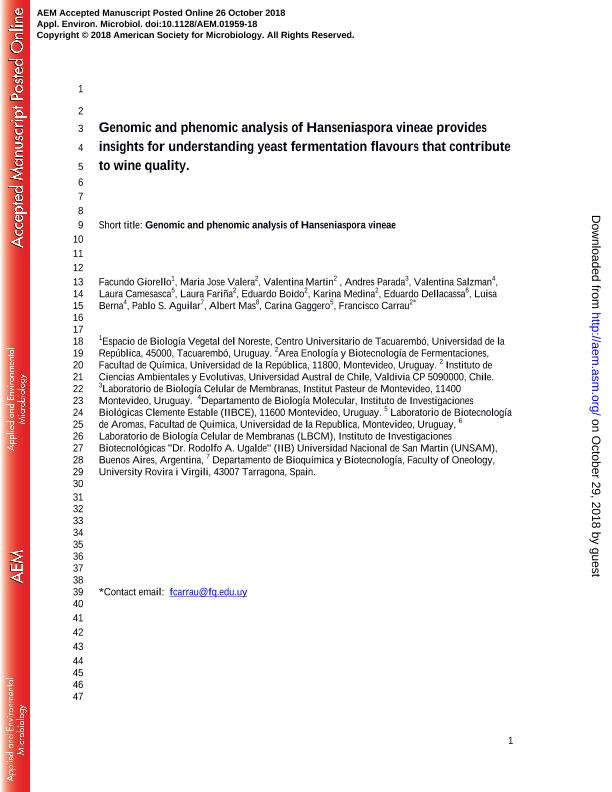Artículo
Genomic and transcriptomic basis of Hanseniaspora vineae's impact on flavor diversity and wine quality
Giorello, Facundo; Valera, Maria Jose; Martín, Valentina ; Parada, Andres; Salzman, Valentina
; Parada, Andres; Salzman, Valentina ; Camesasca, Laura; Fariña, Laura; Boido, Eduardo; Medina, Karina; Dellacassa, Eduardo; Berna, Luisa; Aguilar, Pablo Sebastián
; Camesasca, Laura; Fariña, Laura; Boido, Eduardo; Medina, Karina; Dellacassa, Eduardo; Berna, Luisa; Aguilar, Pablo Sebastián ; Mas, Albert; Gaggero, Carina; Carrau, Francisco
; Mas, Albert; Gaggero, Carina; Carrau, Francisco
 ; Parada, Andres; Salzman, Valentina
; Parada, Andres; Salzman, Valentina ; Camesasca, Laura; Fariña, Laura; Boido, Eduardo; Medina, Karina; Dellacassa, Eduardo; Berna, Luisa; Aguilar, Pablo Sebastián
; Camesasca, Laura; Fariña, Laura; Boido, Eduardo; Medina, Karina; Dellacassa, Eduardo; Berna, Luisa; Aguilar, Pablo Sebastián ; Mas, Albert; Gaggero, Carina; Carrau, Francisco
; Mas, Albert; Gaggero, Carina; Carrau, Francisco
Fecha de publicación:
01/2019
Editorial:
American Society for Microbiology
Revista:
Applied and Environmental Microbiology
ISSN:
0099-2240
Idioma:
Inglés
Tipo de recurso:
Artículo publicado
Clasificación temática:
Resumen
Hanseniaspora is the main genus of the apiculate yeast group that represents approximately 70% of the grape-associated microflora. Hanseniaspora vineae is emerging as a promising species for quality wine production compared to other non-Saccharomyces species. Wines produced by H. vineae with Saccharomyces cerevisiae consistently exhibit more intense fruity flavors and complexity than wines produced by S. cerevisiae alone. In this work, genome sequencing, assembling, and phylogenetic analysis of two strains of H. vineae showed that it is a member of the Saccharomyces complex and it diverged before the whole-genome duplication (WGD) event from this clade. Specific flavor gene duplications and absences were identified in the H. vineae genome compared to 14 fully sequenced industrial S. cerevisiae genomes. The increased formation of 2-phenylethyl acetate and phenylpropanoids such as 2-phenylethyl and benzyl alcohols might be explained by gene duplications of H. vineae aromatic amino acid aminotransferases (ARO8 and ARO9) and phenylpyruvate decarboxylases (ARO10). Transcriptome and aroma profiles under fermentation conditions confirmed these genes were highly expressed at the beginning of stationary phase coupled to the production of their related compounds. The extremely high level of acetate esters produced by H. vineae compared to that by S. cerevisiae is consistent with the identification of six novel proteins with alcohol acetyltransferase (AATase) domains. The absence of the branched-chain amino acid transaminases (BAT2) and acyl coenzyme A (acyl-CoA)/ethanol O-acyltransferases (EEB1) genes correlates with H. vineae's reduced production of branched-chain higher alcohols, fatty acids, and ethyl esters, respectively. Our study provides sustenance for understanding and potentially utilizing genes that determine fermentation aromas.
Palabras clave:
FLAVOR COMPOUNDS
,
GENOME
,
ILLUMINA
,
METABOLOME
,
TRANSCRIPTOME
,
WINE AROMA
Archivos asociados
Licencia
Identificadores
Colecciones
Articulos(IFIBYNE)
Articulos de INST.DE FISIOL., BIOL.MOLECULAR Y NEUROCIENCIAS
Articulos de INST.DE FISIOL., BIOL.MOLECULAR Y NEUROCIENCIAS
Articulos(IIB-INTECH)
Articulos de INST.DE INVEST.BIOTECNOLOGICAS - INSTITUTO TECNOLOGICO CHASCOMUS
Articulos de INST.DE INVEST.BIOTECNOLOGICAS - INSTITUTO TECNOLOGICO CHASCOMUS
Citación
Giorello, Facundo; Valera, Maria Jose; Martín, Valentina; Parada, Andres; Salzman, Valentina; et al.; Genomic and transcriptomic basis of Hanseniaspora vineae's impact on flavor diversity and wine quality; American Society for Microbiology; Applied and Environmental Microbiology; 85; 1; 1-2019
Compartir
Altmétricas



